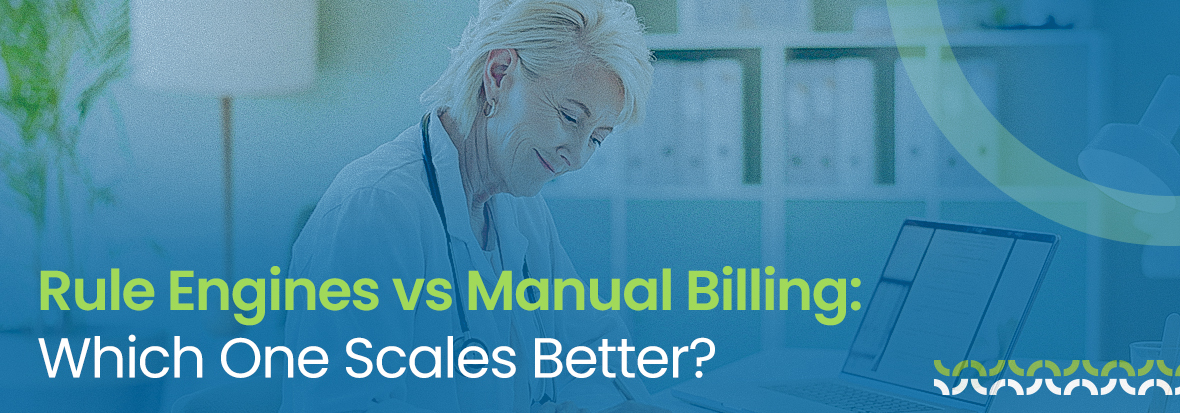Every year across the healthcare industry, billions of dollars are lost because of claim denials, coding mistakes, and billing inefficiencies. Hospitals, clinics, and large systems spend time and money chasing unpaid claims and correcting errors. As denial rates rise (sometimes over 15-20%) alongside administrative burden, manual billing becomes hard to continue with.
Now imagine if, instead of staff manually catching every mistake, a system automatically checked hundreds of rules every time a claim was prepared. A system capable of catching eligibility errors, wrong codes, missing authorization, and other issues in seconds. That’s rule engines in a nutshell. This guide includes the technical differences between manual billing vs rule engines, compares costs, compliance, and security, and shows how rule engines hold up better.
The Differences Between Manual Billing and Rule Engines
Manual billing and rule-engine-driven billing differ in how they handle every step of the healthcare revenue cycle. Understanding these differences helps decide what to adopt. Below are the key contrasts:
How Errors Are Found & Fixed
- Manual Billing: Humans manually inspect claim elements, reading doctor notes, choosing codes, and checking insurance details. Mistakes slip through: missing modifiers, wrong diagnosis-procedure pairings, and eligibility errors. Corrections often happen after denials or payer rejections.
- Rule Engine: Built-in “pre-submission scrubbing” checks each claim against dozens or hundreds of coded rules (e.g, NCCI bundling, MUEs, service-date vs documentation date, missing taxonomy). Some errors are auto-corrected; others are flagged for human attention before sending the claim.
Throughput & Speed
- Manual Billing: Speed limited by staff capacity. More claims, more hours, or more people. Peak volumes or sudden policy changes cause backlogs.
- Rule Engine: High volume can be processed fast. Once rules are set up, many claims go through automatically or with minimal human review.
Policy/Rules Changes
- Manual Billing: Practices keep up via training, reading payer policy updates, and disseminating updates to coders and billers. The lag between policy change and staff fully adapting means more errors during that window.
- Rule Engine: Rules are centralized. When a payer changes a policy or a new CPT/ICD code is released, rule sets are updated only once, tested, versioned, and then deployed. All future claims are evaluated under the new rules immediately.
Consistency & Variability
- Manual Billing: High variability. Two coders might interpret similar documentation differently. Staff fatigue or turnover exacerbates inconsistency.
- Rule Engine: Consistent decision logic: same rules applied in the same way every time. Less variance. Overrides or exception workflows preserve judgment when needed, but standard cases are uniformly handled.
Problem Identification
| Billing Step | Manual Billing Detects Errors When… | Rule Engine Detects Errors When… |
|---|---|---|
| Registration / Eligibility | Staff enter insurance info manually, may miss inactive policies, wrong payer IDs, or coverage limits until the claim is submitted or rejected. | Engine checks real-time eligibility, flags inactive insurance or missing info before proceeding further. |
| Charge Capture & Coding | Coders relying on memory or payer bulletins can miss modifier rules, contradictory codes, and outdated codes. | Engine enforces bundling logic (NCCI), global periods, and proper modifiers; automatically suggests or applies fixes. |
| Pre-Submission Scrubbing | Staff follow checklists; they may miss subtle mismatches (e.g., provider location vs POS, or taxonomy wrong), or fail to attach required documentation. | Engine runs myriad validation rules, checks attachments, verifies provider IDs, ensures formatting correctness, etc. |
| Submission & Clearinghouse Interface | Rejects due to formatting, missing payer IDs, and invalid NPIs; staff must catch and resubmit. | Engine validates claim format (payer ID, NPI, provider info), reducing rejects and resubmissions. |
| Denial Management / Payment Posting | Staff interpret EOB/835s, manually identify root causes; trend detection is slow. | Engine or supporting analytics track common denial reasons, trend by payer or code, and help direct corrective action. |
Technical Ways Rule Engine is Better Than Manual Billing
Below are several detailed, technical advantages rule engines bring over manual billing, with real metrics, rule types, and use cases. Useful especially for practices trying to decide whether to adopt automation.
Automatic Adherence to NCCI / MUE / Code Edits
Many payers and CMS use NCCI edits (Procedure-to-Procedure, Add-On Code edits, etc.) and Medically Unlikely Edits (MUEs). These are rules about what code combinations are allowed, how many units can be billed, and what modifiers are required.
| Manual Billing Challenge | Rule Engine Advantage |
|---|---|
| Staff must look up each code, check code combinations, figure out which codes are bundled, and which modifiers are allowed; human error here is common, especially when edits change quarterly. | Automatically enforce NCCI/PTP and MUE rules. If a claim violates a code pair, it is flagged. Suppose units exceed MUE, flagged. The rule engine uses the latest published versions of these edit tables to check each claim before submission. |
Real-Time Eligibility & Benefit Verification
Confirming that a patient’s insurance is active, that the plan covers the service, whether preauthorization is required, etc., before delivering the service or preparing the claim.
| Manual Billing Problem | Rule Engine Benefit |
|---|---|
| Staff often verify eligibility manually via phone or the payer portal. Errors occur due to mismatches (wrong payer, plan changes, lapsed coverage), leading to avoidable denials. | Automated eligibility verification via API or data feed. Can flag inactive policies or coverage gaps immediately. Reduce surprises post-service. |
Automated Modifier Logic, Diagnostics-Procedure Matching, and Pattern Detection
Many denials are caused by missing or wrong modifiers, misaligned diagnosis vs procedure (e.g., coding a procedure that isn’t supported by the diagnosis), or inconsistent provider taxonomy or place of service.
| Manual Billing Challenge | Rule Engine Advantage |
|---|---|
| Coders must remember many rules, refer to payer guidelines, and check modifiers; they are prone to oversight. | Codify these modifier rules and code-diagnosis relationships so that claims violating those are flagged. Can suggest or even auto-insert valid modifiers if the logic is certain. |
Faster, Accurate Charge Review & Pre-Submission Scrubbing
Before a charge is sent for claim generation, every field (code, diagnosis, modifier, provider ID, place of service, date, documentation) is checked for completeness and correctness.
| Manual Billing Problem | Rule Engine Benefit |
|---|---|
| Many claims get partially filled, documentation is missing, provider NPIs are invalid or mismatched, or required attachments are not included. These cause rejections or denials (clearinghouse rejects or payer rejections). | Automated scrubbing of charge data. A Charge Review Rules Engine sits between EHR and the billing system to intercept charges with missing or incorrect data so staff don’t waste effort downstream. |
Denial Analytics & Trend Tracking
Collecting data on which claims are denied, why, for which payer, or which codes, and feeding that into decision-making to adjust rules or training.
| Manual Billing Challenge | Rule Engine Advantage |
|---|---|
| Denial tracking is often manual and sporadic; by the time trends are spotted, many claims have already been lost, or the appeal work backlog has grown. | Integrated analytics dashboards that show “denial by reason” (modifier, auth missing, eligibility, code mismatch), trend over time, and payer-by-payer breakdown. |
Adaptability & Rule Versioning
Policy changes (CPT/ICD code updates, CMS policy, payer rules) need to be integrated into billing logic without downtime or chaos.
| Manual Billing Problem | Rule Engine Benefit |
|---|---|
| New rules require training, communication, and often misinterpretation or lag; transition periods cause spikes in denials. | Central repository for rules, version control; can test new rules against historical claims; roll out updated logic in a controlled manner. Changes are applied uniformly across all claims going forward. |
Want to shift to rule engines but finding it complex?
Cost Comparison of Both Billing Options
Upfront/One-Time Costs
Manual Billing
Manual billing requires hiring staff (billers, coders, eligibility/denial managers), providing computers, offices, and training programs. These are recurring overheads even if claim volumes fluctuate.
Rule Engines
Rule-engine adoption involves software licensing or subscription fees, implementation and integration with your EHR / practice management/clearinghouse, building rule sets, and training people to use the new workflows. Sometimes consultants are needed for custom rules.
Ongoing & Hidden Costs (What You Keep Paying Without Realizing)
Manual Billing
With manual billing, you pay in staff hours: checking documentation, re-entering data, and correcting mistakes. Mistakes cost double or triple when they cause denials/resubmissions.
Rule Engines
Rule engines cost upkeep: rule updates as payer or coding policies change, system maintenance, and occasional human review of exceptions. But many automated tasks (eligibility checks, coding logic, modifiers) become near-zero marginal cost after the system is running.
Compliance and Security Comparison
Ensuring billing systems are secure and compliant is non-negotiable in healthcare. Below are important compliance/security concerns, and how manual billing stacks up against rule engines.
| Key Areas | Manual Billing: Where Risks Are Higher | Rule Engines: How They Improve Security & Compliance |
|---|---|---|
| Audit Trails & Logging | Logs are minimal or inconsistent; it’s hard to see who changed what and when after the fact. | Automatically logs each rule fired, who triggered it, when, outcome (flag, correction, exception), with versioned records. |
| Policy Change Enforcement | New coding, payer, or privacy rules may be applied unevenly or late; staff training lags behind changes. | A central rule repository ensures every claim follows the newest policy once rules are updated, and ensures consistent enforcement. |
| Access Controls & Data Security | Manual handoffs, paper/spreadsheets, weak user controls; potential exposure of PHI through human error. | Role-based access, encryption of data in transit & at rest, secure infrastructure aligning with technical HIPAA safeguard standards. |
| Vendor / Third-Party Risk & Oversight | Outsourced billing, data hosting, etc., sometimes without strong contracts or oversight; unclear liabilities. | Vendors with SOC-2 or similar certifications; clear Business Associate Agreements; vendor oversight, regular security assessments, and patching. |
Conclusion
Manual billing, though familiar and trusted, simply can’t keep up with the speed, complexity, and regulatory pressure healthcare faces today. Errors from incorrect codes to missing authorizations pile up, denials increase, and revenue leaks occur. Each mistake costs time and money, and manual teams don’t always have the bandwidth or consistency to catch every change in payer rules or compliance requirements.
Rule engines offer a different path: automated checks, instant feedback, audit-friendly records, and consistent enforcement of rules. Yes, there’s an upfront cost and setup effort, but the payoff in reduced denials, faster payments, and stronger compliance can be dramatic. Whether you run a small clinic or a large health system, the smarter move is to blend human oversight with rule-based automation.

